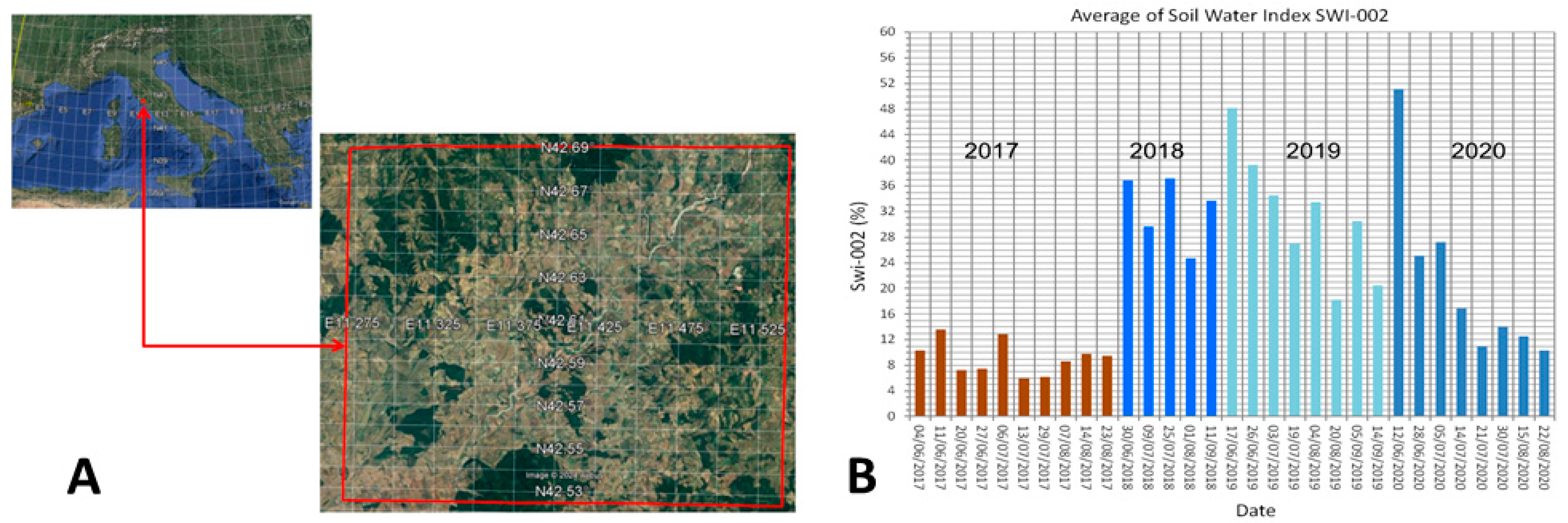Surface Soil Moisture Evaluated from Satellite Multispectral Optical Data Through Visible and Shortwave Drought Index and Its Comparison with Microwave-Based Soil Moisture Products †
Abstract
1. Introduction
2. Materials and Methods
2.1. Study Area
2.2. Data
2.3. Methodology
3. Results
4. Conclusions
Author Contributions
Funding
Institutional Review Board Statement
Informed Consent Statement
Data Availability Statement
Conflicts of Interest
References
- Bolten, J.D.; Crow, W.T.; Zhan, X.; Jackson, T.J.; Reynolds, C.A. Evaluating the Utility of Remotely Sensed Soil Moisture Retrievals for Operational Agricultural Drought Monitoring. IEEE J. Sel. Top. Appl. Earth Obs. Remote Sens. 2010, 3, 57–66. [Google Scholar] [CrossRef]
- Xing, M.; Chen, L.; Wang, J.; Shang, J.; Huang, X. Soil Moisture Retrieval Using SAR Backscattering Ratio Method during the Crop Growing Season. Remote Sens. 2022, 14, 3210. [Google Scholar] [CrossRef]
- Jackson, T. Vegetation Water Content Mapping Using Landsat Data Derived Normalized Difference Water Index for Corn and Soybeans. Remote Sens. Environ. 2004, 92, 475–482. [Google Scholar] [CrossRef]
- Gonnelli, A.; Carlà, R.; Baronti, S.; Raimondi, V. Near-Infrared and Short-Wavelength Infrared-Based Indices to Monitor Soil Moisture from a Satellite: A Comparative Analysis. Eng. Proc. 2023, 51, 29. [Google Scholar] [CrossRef]
- Marschallinger, B.B.; Paulik, C.; Jacobs, T. Soil Water Index Product User Manual-Copernicus Global Land Operations. Available online: https://land.copernicus.eu/en/technical-library/product-user-manual-soil-water-index (accessed on 13 January 2025).
- Zhang, N.; Hong, Y.; Qin, Q.; Liu, L. VSDI: A Visible and Shortwave Infrared Drought Index for Monitoring Soil and Vegetation Moisture Based on Optical Remote Sensing. Int. J. Rem. Sens. 2013, 34, 4585–4609. [Google Scholar] [CrossRef]
- Tucker, C.J. Red and photographic infrared linear combinations for monitoring vegetation. Rem. Sens. Environ. 1979, 8, 127–150. [Google Scholar] [CrossRef]
- Richardson, A.J.; Wiegand, C.L. Distinguishing vegetation from soil background information. Photogram. Eng. Rem. Sens. 1977, 43, 1541–1552. [Google Scholar]
- Huete, A.R.; Jackson, R.D.; Post, D.F. Spectral response of a plant canopy with different soft backgrounds. Rem. Sens. Environ. 1985, 17, 37–53. [Google Scholar]


| VSDI | VSDI NDVI > 0.4 | VSDI NDVI ≤ 0.4 | VSDI NDVI ≤ 0.35 | |
|---|---|---|---|---|
| Dataset | whole dataset | only vegetated areas | bare soil and poorly vegetated areas | bare soil |
| Pearson coefficient | 0.402 | 0.419 | 0.630 | 0.668 |
| Number of pixels | 17,305 | 10,379 | 6866 | 3250 |
Disclaimer/Publisher’s Note: The statements, opinions and data contained in all publications are solely those of the individual author(s) and contributor(s) and not of MDPI and/or the editor(s). MDPI and/or the editor(s) disclaim responsibility for any injury to people or property resulting from any ideas, methods, instructions or products referred to in the content. |
© 2025 by the authors. Licensee MDPI, Basel, Switzerland. This article is an open access article distributed under the terms and conditions of the Creative Commons Attribution (CC BY) license (https://creativecommons.org/licenses/by/4.0/).
Share and Cite
Carlà, R.; Baronti, S.; Raimondi, V. Surface Soil Moisture Evaluated from Satellite Multispectral Optical Data Through Visible and Shortwave Drought Index and Its Comparison with Microwave-Based Soil Moisture Products. Proceedings 2025, 129, 29. https://doi.org/10.3390/proceedings2025129029
Carlà R, Baronti S, Raimondi V. Surface Soil Moisture Evaluated from Satellite Multispectral Optical Data Through Visible and Shortwave Drought Index and Its Comparison with Microwave-Based Soil Moisture Products. Proceedings. 2025; 129(1):29. https://doi.org/10.3390/proceedings2025129029
Chicago/Turabian StyleCarlà, Roberto, Stefano Baronti, and Valentina Raimondi. 2025. "Surface Soil Moisture Evaluated from Satellite Multispectral Optical Data Through Visible and Shortwave Drought Index and Its Comparison with Microwave-Based Soil Moisture Products" Proceedings 129, no. 1: 29. https://doi.org/10.3390/proceedings2025129029
APA StyleCarlà, R., Baronti, S., & Raimondi, V. (2025). Surface Soil Moisture Evaluated from Satellite Multispectral Optical Data Through Visible and Shortwave Drought Index and Its Comparison with Microwave-Based Soil Moisture Products. Proceedings, 129(1), 29. https://doi.org/10.3390/proceedings2025129029






